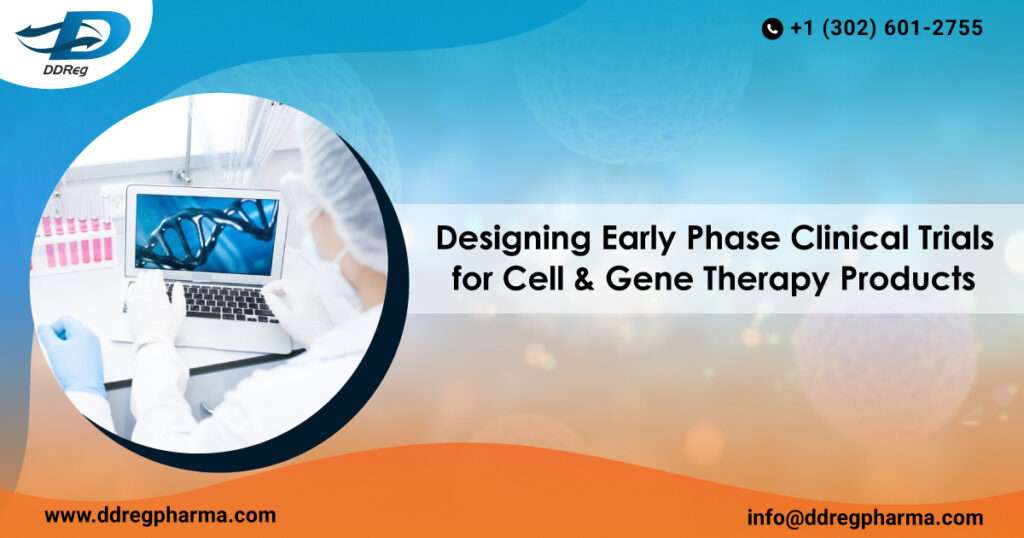Early-phase clinical trials for cell and gene therapy (CGT) products differ from those for other pharmaceuticals due to unique product features and previous clinical experiences, which have revealed substantial risks, including multi-organ failure, leukemia, and tumor development. Factors such as prolonged biological activity, immunogenicity, and invasive administration procedures contribute to these risks. The design of CGT trials requires careful consideration of safety, preclinical, and chemistry, manufacturing & control (CMC) complexities that are not typically seen with other pharmaceutical products.
Regulatory agencies have been providing sponsors with guidelines to help navigate requirements for designing early-phase clinical trials for CGT products to address key aspects. These include (but are not limited to) identifying CGT product features and design of early phase clinical trial as per these features as well as recommendations for Investigational New Drug (IND) submissions and meetings. Guidance documents by stringent regulatory authorities, like the US FDA’s “Consideration for the Design of Early-Phase Clinical Trials of Cellular and Gene Therapy Products” provides a robust framework. This guidance focuses on safety, tolerability, and feasibility assessments in trials under the Office of Cellular, Tissue, and Gene Therapies (OCTGT) for products that meet the definition of “biological product” With the increasing interest in CGT products due to their medical potential, this guidance aims to facilitate their development, providing complementary recommendations to previous guidance documents.
CGT product features that influence the design of clinical trials
When planning clinical trials, special considerations must be made for the development of CGT products. Clinical experience is limited for both these products, therefore they have very long half-life as well as immunogenicity which influences how a trial is organized. In these cases, there are risks related to donors and migration that can change the dynamics of this kind of test than in other medical treatment options. This implies that GT product during trial design should be associated with uncontrolled gene expression, genomic changes and elimination. Thus, the trial for gene-modified cellular products has to be cautiously built so as to embrace qualities and hazards of both listed categories at Once.
Moreover, these approaches are made complicated by product-specific factors such as complexity limits, dose control limits and viability constraints especially in relation to patient specific samples. On the other hand, preclinical studies can be meaningful, but they might not answer questions regarding dosing or how drugs move within the body in situations where extrapolation from animal models is not feasible or reliable. Because of this, the FDA guidelines offer suggestions for designing first-in-human trials with reference to safety/efficacy balance and medical progressiveness of CGT products.
Design of early-phase clinical trials for CGT products
Early-phase clinical trials for CGT products prioritize safety evaluation and gather preliminary evidence of effectiveness. Dose exploration is crucial to identify the Maximum Tolerated Dose (MTD) or optimal effective doses, considering product and population characteristics. Feasibility assessments address manufacturing and administration challenges, while activity assessments offer secondary insights into effectiveness. Selection of the study population considers risk, benefits, and disease characteristics, with additional precautions for pediatric subjects.
Control groups and blinding aid in safety data interpretation, particularly in invasive procedures or pediatric trials. Preclinical data guide dose determination, often escalating in half-log increments with single-dose regimens and staggered administration to mitigate safety risks. Operator training and contingency plans ensure consistency and subject safety. Monitoring and follow-up protocols include safety assessments and product-specific evaluations, with study stopping rules to manage risks and ensure subject safety through collaboration with regulatory authorities and thorough documentation.
Meetings with the Office of Cellular, Tissue, and Gene Therapies of the US FDA
Sponsors developing CGT products, particularly those with limited IND process experience or targeting rare diseases, are invited to collaborate with FDA’s OCTGT for meetings. These meetings’ aim is to guide in preparing IND submissions and development programs in general, increasing the probability of obtaining successful trial support and marketing application approval. With the purpose to ensure that proper groundwork is laid for their planned trials, the FDA offers sponsors formal meetings such as pre-IND meetings. These discussions focus on a range of clinical aspects including safety rationale and selection of study population, dosage parameters, safety monitoring plans and overall clinical development strategies. Sponsors also can turn to other related resources like FDA guidance documents or OCTGT Learn webinars which help them prepare more comprehensive IND submissions and navigate through CGT product’s developmental pathway.
Conclusion
The Office of Cellular, Tissue, and Gene Therapies (OCTGT) offers valuable insights for sponsors and investigators in designing Phase 1 and some Phase 2 clinical trials for Cellular Therapy (CT) and Gene Therapy (GT) products, emphasizing on the importance of careful trial design, dose exploration, selection of study populations, and monitoring and follow-up protocols tailored to the specific characteristics of CGT products. Additionally, OCTGT encourages sponsors to engage in meetings and utilize available resources to ensure successful trial planning and execution, ultimately advancing the development of CGT products and contributing to medical progress.
As part of its pharmaceutical product portfolio, DDReg provides regulatory solutions for biotechnology products along the entire product lifecycle. With experience of over 120 regulatory agencies and subject matter expertise, DDReg is the go-to-partner for pharmaceutical regulatory services. Read more from the experts: Harmonization for the Development of Cell and Gene Therapies.

